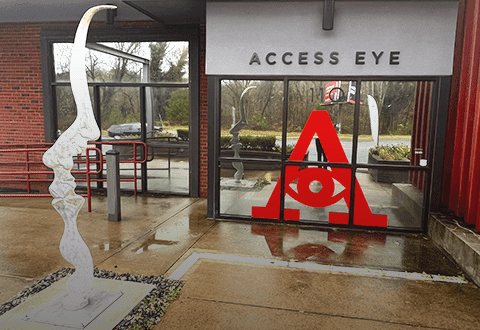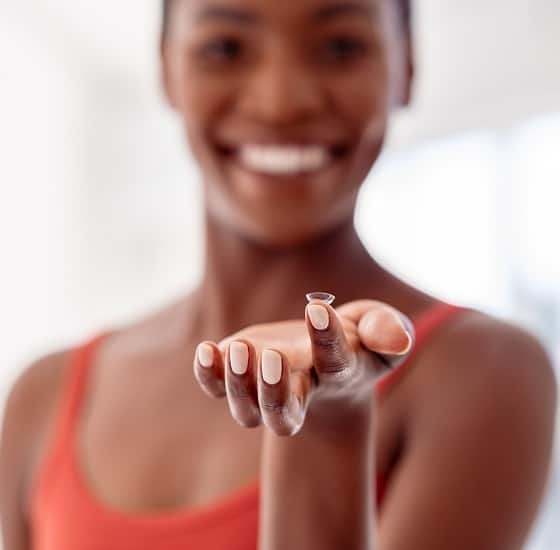Contact Lenses in Fredericksburg
Also Serving Spotsylvania, Stafford & King George
Patients in Fredericksburg and the surrounding region visit the eye experts at Access Eye because they know they can count on our team to provide them with comfortable, practical and affordable contact lenses. If you have decided to make the switch to contact lenses or would like some guidance on potentially finding a new type of contact lens, we are happy to assist.

Types of Contact Lenses
Soft Lenses
Soft lenses are made of malleable plastic that allows oxygen to flow through easily to the cornea. They tend to be more comfortable on the eyes than hard lenses. Soft lenses are inherently considered disposable, though the rate at which they are tossed out depends on the specific kind. Some lenses are meant to be thrown out every day, while others can be rinsed and reused for a week or month at a time.
Rigid Gas Permeable Lenses
RGP lenses are harder and more durable than soft lenses. They are also capable of providing somewhat crisper vision, even if they are not as comfortable as soft lenses. Because they are not meant to be replaced as often, RGP lenses are usually the less expensive contact option over an extended timeframe.
Specialty Lenses
Specialty lenses are designed for patients who find traditional lenses uncomfortable or unsatisfactory. They usually have a unique shape so that they may fit better over the cornea. For example, toric lenses may be the best option for correcting astigmatism (a misshapen cornea). Scleral lenses are larger lenses that rest on the white of the eye (the sclera) specifically to avoid touching the cornea.
Using and Caring for Contact Lenses
Aside from certain lenses that you can wear continuously, contact lenses are meant to be removed at night when you sleep. Wash your hands and dry them thoroughly before handling your contact lenses — every time — and never clean your lenses with tap water. When not in use, contact lenses should be stored in a contact case with disinfecting solution. Keep the case clean between use to avoid a bacterial buildup.
Inserting Contact Lenses
With clean hands, use contact solution to rinse your contact. Carefully place the lens on the fingertip of your index or middle finger with the rounded portion on the finger so that it looks like an upright bowl. Hold the lens up to the light to make sure it is in pristine condition. If there is any damage (like a chip, crack or scratch), do not put it in your eye.
While looking in the mirror, use your other hand to hold open both the upper and lower eyelids. Continue looking forward or slightly upward and then gently press the lens against your iris (the colored portion of your eye). Blink your eyes to ensure it feels comfortable and secure. If not, remove it and start over.
Repeat this process for the other eye.
Removing Contact Lenses
After washing your hands, use your non-dominant hand to hold your upper lid open and use your middle of your dominant hand to pull down the lower lid. Next, use the thumb and index fingers on your dominant hand to carefully touch and pinch the lens (using a mirror to help guide you) and gently remove it from the eye.
If you find it challenging to grip the lens, apply contact solution to your fingers. If it still poses a problem, you may be able to slide the (soft) lens to the corner of your eye where it will more easily fall out.
The same process should be repeated to remove the lens in the other eye.
King George Office
7961 Kings Highway
King George, VA 22485
Phone: (540) 371-2020
Office Hours
Ophthalmology in King George, VA Hours
Mondays – 8:00am to 5:00pm
Tuesdays – 8:00am to 5:00pm
Wednesdays – 8:00am to 5:00pm
Thursdays – 8:00am to 5:00pm
Fridays – 8:00am to 5:00pm
Closed for lunch from 1:00pm to 2:00pm
Falmouth Office
110 Cambridge Street
Fredericksburg, VA 22405
(540) 371-2020
Office Hours
Ophthalmology in Falmouth, VA Hours
Monday – 8:00am to 5:00pm
Tuesday – 8:00am to 5:00pm
Wednesday – 8:00am to 5:00pm
Thursday – 8:00am to 5:00pm
Friday – 8:00am to 5:00pm
Route 3 Office
4516 Plank Road
Fredericksburg, VA 22407
(540) 371-2020
Office Hours
Ophthalmology in Fredericksburg, VA Hours
Monday – 8:00am to 5:00pm
Tuesday – 8:00am to 5:00pm
Wednesday – 8:00am to 5:00pm
Thursday – 8:00am to 5:00pm
Friday – 8:00am to 5:00pm
Parkway Office
4701 Spotsylvania Parkway
Suite 110
Fredericksburg, VA 22408
Office Hours
Ophthalmology in Spotsylvania, VA Hours
Mondays – 8:00am to 5:00pm
Tuesdays – 8:00am to 5:00pm
Wednesdays – 8:00am to 5:00pm
Thursdays – 8:00am to 5:00pm
Fridays – Temporarily Closed
Closed for lunch 1:00pm -2:00pm
Dedicated Laser Center
4516 Plank Rd
Fredericksburg, VA 22407
(540) 371-2020
Office Hours
Dedicated Laser Center Hours
Refer to hours listed for the Plank Road Location
Aquia Office
2761 Richmond Highway
Suite 205
Stafford VA, 22554
Office Hours
Ophthalmology in Stafford, VA Hours
Mondays – 8:00am to 5:00pm
Tuesdays – 8:00am to 5:00pm
Wednesdays – 8:00am to 5:00pm
Thursdays – 8:00am to 5:00pm
Fridays – 8:00am to 5:00pm
Closed for lunch 1:00pm -2:00pm



















